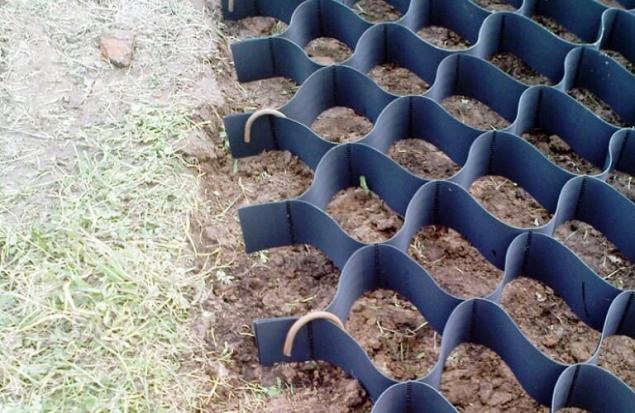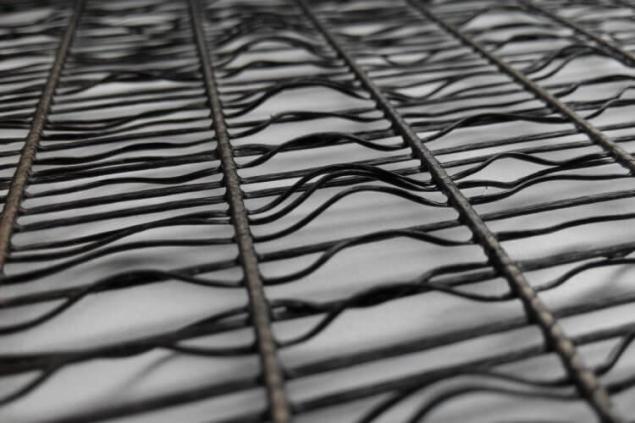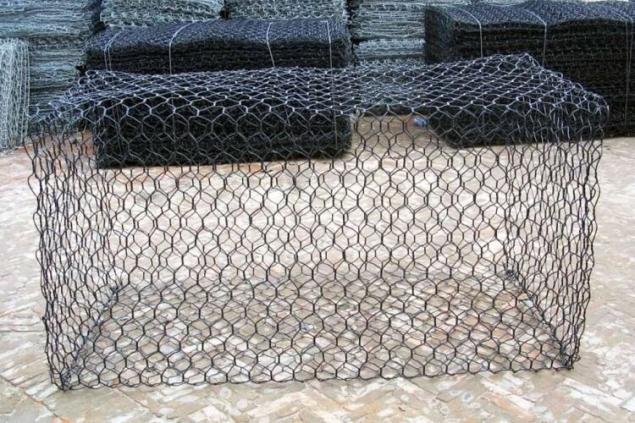The strengthening of the walls of the drain groove: five best ways
 Bashny.Net
Bashny.Net
Drainage is necessary for most plots on which only built or will be built a house. This design is not cheap, therefore, prudent owners often strive to save money, causing damage to the quality of the construction. You can do this by establishing at the site the drainage open. It is a system of interconnected grooves that efficiently expel excess water.
The main thing – to strengthen their walls to protect from fraying. You need to know that not all the grooves need such arrangement. If the angle of inclination of the walls less than 8%, they can not be strengthened. The slopes on an incline of 8 and up to 15% better to fix geomate or geogrids. If the inclination of the walls is greater than 15%, use internal reinforcement.
A detailed look at the five most effective methods of strengthening of slopes of the drainage trenches.
Use geomat
This cover is made in a kind of plexus three layers of volumetric meshes of polypropylene. Grilles have double orientation and fastened together with polypropylene yarns. The result is a material like porous three-dimensional sponge. It is well establishes the ground but do not represent obstacles to the development of plants.
Anti-erosion coating is durable and resistant to corrosive environments and microorganisms. It is non-toxic, impervious to sharp temperature fluctuations and poorly lit. Over time, the structure geomat is only strengthened by the fact that the roots of the plant entwine polypropylene lattice. The coating is very easy to install, and to do this you can even in the winter.
Before you strengthen the walls of the groove must be clean of debris and leveling. Then proceed to rolling the roll geomate. Its edge is securely attached to the top of the trench, the material falls down, cut strip desired length. The following panel cover is laid on the first with a small overlap. Laid are monofilament covered with soil layer 4-5 cm Later it are sown the plants.
Installation of volumetric geogrid
Anti-erosion material is made in the form of three-dimensional designs. It is a plastic tape, welded together in a checkerboard pattern. The result is a durable synthetic frame consisting of cells of the same size. In them is filled up the filler, which is selected based on the operating conditions of the structure. Here can be used gravel, sand, pebbles, etc.
There are two types of joycec: with perforated and solid walls. The first option has the best drainage characteristics, and that they are encouraged to strengthen the slopes of the grooves. In addition, the geogrid may have different size cells and wall heights. In any case, the material has a high strength and flexibility. It does not rot and is resistant to various aggressive environments.
The mounting surface is simple enough. The walls of the grooves are aligned and compacted. If necessary, cover them with a geotextile, and then in a downward direction lay the geogrid. Is assigned to the upper and lower edge of the cover. With the bottom fasteners are installed after the material is stretched and acquire the desired shape. The resulting cell is filled with a filler.
Consolidation of the walls of the three-dimensional geogrid
The material is intended for consolidation and reinforcement of steep slopes. It is a polymeric mesh interwoven structure, which greatly enhances firmware monofilament. To give even greater strength of the coating are impregnated with special compounds. The structure of the material does not interfere with plant growth, the roots which strengthen the crumbling slope of the groove.
Geogrid is non-toxic, easy to tolerate considerable stress and temperature changes, are insensitive to aggressive environments, are durable, do not rot. Moreover, the operation characteristics of the coating remain unchanged. It can withstand ground motion, subsidence and frost heave. Can be used for strengthening of surfaces of any configuration.
Before laying anti-erosion material, the slope is cleared, leveled and compacted with roller. The mesh is unrolled on the wall, and every 1.5 m fixed l-shaped anchor fasteners or metal brackets. Each strip of material placed back to back with the previous one. Laid geogrid is covered with a thin layer of soil or decorative filling, over which the plants are planted.
Installation of gabions
For strengthening of slopes well suited to the box-shaped gabions, which constitute a wire mesh cage filled with pebbles, gravel, stone, etc., the Structure of such decorative structures shall not preclude the drainage process. At the same time they prevent the removal of soil from the walls of the trench, strengthen its slopes and beautify the landscape. Over time, the effectiveness of the gabion is increasing. The service life of such structures is tens of years.
For installation, you can purchase ready-made designs or make them yourself, which is not so difficult. Frames future gabion welded from metal rods, filled with selected filling and closing mesh-netting. For elements it is advisable to choose a material with corrosion-resistant coating, otherwise the finished design will last long and it will have to fix. published
Source: www.stroitelstvo365.ru/kanalizatsionnie-sistemi/ukreplenie-stenok-drenazhnoj-kanavki
The main thing – to strengthen their walls to protect from fraying. You need to know that not all the grooves need such arrangement. If the angle of inclination of the walls less than 8%, they can not be strengthened. The slopes on an incline of 8 and up to 15% better to fix geomate or geogrids. If the inclination of the walls is greater than 15%, use internal reinforcement.
A detailed look at the five most effective methods of strengthening of slopes of the drainage trenches.
Use geomat

This cover is made in a kind of plexus three layers of volumetric meshes of polypropylene. Grilles have double orientation and fastened together with polypropylene yarns. The result is a material like porous three-dimensional sponge. It is well establishes the ground but do not represent obstacles to the development of plants.
Anti-erosion coating is durable and resistant to corrosive environments and microorganisms. It is non-toxic, impervious to sharp temperature fluctuations and poorly lit. Over time, the structure geomat is only strengthened by the fact that the roots of the plant entwine polypropylene lattice. The coating is very easy to install, and to do this you can even in the winter.
Before you strengthen the walls of the groove must be clean of debris and leveling. Then proceed to rolling the roll geomate. Its edge is securely attached to the top of the trench, the material falls down, cut strip desired length. The following panel cover is laid on the first with a small overlap. Laid are monofilament covered with soil layer 4-5 cm Later it are sown the plants.
Installation of volumetric geogrid

Anti-erosion material is made in the form of three-dimensional designs. It is a plastic tape, welded together in a checkerboard pattern. The result is a durable synthetic frame consisting of cells of the same size. In them is filled up the filler, which is selected based on the operating conditions of the structure. Here can be used gravel, sand, pebbles, etc.
There are two types of joycec: with perforated and solid walls. The first option has the best drainage characteristics, and that they are encouraged to strengthen the slopes of the grooves. In addition, the geogrid may have different size cells and wall heights. In any case, the material has a high strength and flexibility. It does not rot and is resistant to various aggressive environments.
The mounting surface is simple enough. The walls of the grooves are aligned and compacted. If necessary, cover them with a geotextile, and then in a downward direction lay the geogrid. Is assigned to the upper and lower edge of the cover. With the bottom fasteners are installed after the material is stretched and acquire the desired shape. The resulting cell is filled with a filler.
Consolidation of the walls of the three-dimensional geogrid

The material is intended for consolidation and reinforcement of steep slopes. It is a polymeric mesh interwoven structure, which greatly enhances firmware monofilament. To give even greater strength of the coating are impregnated with special compounds. The structure of the material does not interfere with plant growth, the roots which strengthen the crumbling slope of the groove.
Geogrid is non-toxic, easy to tolerate considerable stress and temperature changes, are insensitive to aggressive environments, are durable, do not rot. Moreover, the operation characteristics of the coating remain unchanged. It can withstand ground motion, subsidence and frost heave. Can be used for strengthening of surfaces of any configuration.
Before laying anti-erosion material, the slope is cleared, leveled and compacted with roller. The mesh is unrolled on the wall, and every 1.5 m fixed l-shaped anchor fasteners or metal brackets. Each strip of material placed back to back with the previous one. Laid geogrid is covered with a thin layer of soil or decorative filling, over which the plants are planted.
Installation of gabions

For strengthening of slopes well suited to the box-shaped gabions, which constitute a wire mesh cage filled with pebbles, gravel, stone, etc., the Structure of such decorative structures shall not preclude the drainage process. At the same time they prevent the removal of soil from the walls of the trench, strengthen its slopes and beautify the landscape. Over time, the effectiveness of the gabion is increasing. The service life of such structures is tens of years.
For installation, you can purchase ready-made designs or make them yourself, which is not so difficult. Frames future gabion welded from metal rods, filled with selected filling and closing mesh-netting. For elements it is advisable to choose a material with corrosion-resistant coating, otherwise the finished design will last long and it will have to fix. published
Source: www.stroitelstvo365.ru/kanalizatsionnie-sistemi/ukreplenie-stenok-drenazhnoj-kanavki
Tags
See also
5 best ways to self-study of English. And it's free!
Olga Butakova: the TOP 30 ways to get cancer!
Cellulite on stomach: the best ways of dealing
The best ways to get rid of delayed onset muscle soreness
How to overclock the metabolism: the 5 best ways
The best way to combat depression is to change the image
Travel India
The best ways to quickly relieve stress
The best way to prove that a person has died

















